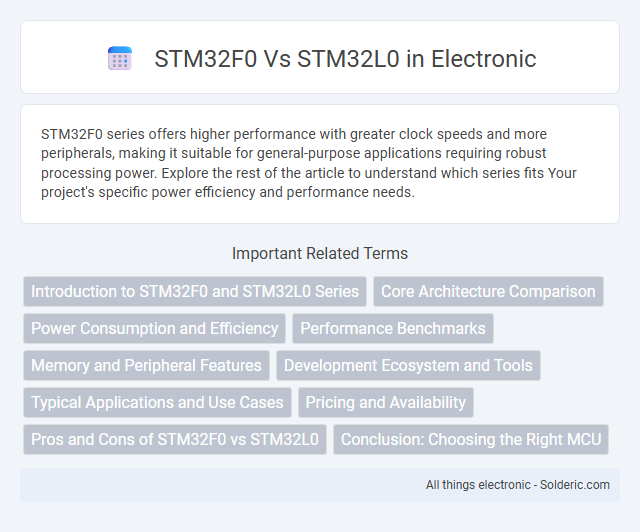STM32F0 series offers higher performance with greater clock speeds and more peripherals, making it suitable for general-purpose applications requiring robust processing power. Explore the rest of the article to understand which series fits Your project's specific power efficiency and performance needs.
Comparison Table
| Feature | STM32F0 Series | STM32L0 Series |
|---|---|---|
| Core | ARM Cortex-M0 (48 MHz) | ARM Cortex-M0+ (32 MHz) |
| Power Consumption | Medium power | Ultra-low power |
| Flash Memory | Up to 128 KB | Up to 192 KB |
| SRAM | Up to 8 KB | Up to 20 KB |
| Operating Voltage | 2.0 V to 3.6 V | 1.65 V to 3.6 V |
| Timers | Basic and Advanced Timers | Low-power Timers |
| ADC | 12-bit ADC | 12-bit ADC with low power |
| Communication Interfaces | USART, SPI, I2C, CAN | USART, SPI, I2C |
| Target Applications | Cost-sensitive applications | Battery-powered, energy-efficient devices |
Introduction to STM32F0 and STM32L0 Series
STM32F0 Series offers a cost-effective 32-bit ARM Cortex-M0 microcontroller solution optimized for entry-level applications with a balance of performance and power efficiency. STM32L0 Series targets ultra-low-power applications using the same ARM Cortex-M0+ core, ensuring extended battery life with advanced low-power modes and energy-saving features. Your choice hinges on whether your project prioritizes cost efficiency or the longest battery life in embedded system design.
Core Architecture Comparison
The STM32F0 series features an ARM Cortex-M0 core optimized for cost-sensitive embedded applications, delivering efficient performance at up to 48 MHz. The STM32L0 series employs an ARM Cortex-M0+ core, designed with enhanced low-power consumption and improved efficiency, running up to 32 MHz. Your choice between STM32F0 and STM32L0 depends on whether core performance or ultra-low power operation is the priority in your application.
Power Consumption and Efficiency
The STM32L0 series offers significantly lower power consumption with ultra-low-power features like Stop and Standby modes drawing as little as 300 nA, making it ideal for energy-sensitive applications. In contrast, the STM32F0 series, while efficient for general-purpose tasks, consumes more power during active operation with typical consumption around several milliamps. The STM32L0's optimized energy efficiency enables longer battery life, especially in IoT and wearable devices where power efficiency is critical.
Performance Benchmarks
STM32F0 series delivers higher CPU clock speeds up to 48 MHz, enabling faster processing suitable for performance-critical applications, while STM32L0 operates up to 32 MHz but excels in energy efficiency. Benchmark tests reveal STM32F0's Cortex-M0 core outperforms STM32L0's Cortex-M0+ in raw speed, making it ideal where processing power is prioritized over power consumption. Your choice depends on whether peak performance or ultra-low power operation is more critical for your embedded project.
Memory and Peripheral Features
STM32F0 microcontrollers offer up to 128 KB of Flash memory and 8 KB of SRAM, optimized for general-purpose applications with enhanced peripheral options like USB, SPI, and ADC. STM32L0 devices provide lower power consumption with up to 192 KB of Flash memory and 20 KB of SRAM, featuring advanced peripherals such as real-time clock, comparator, and ultra-low-power timers. Both families support various communication interfaces, but STM32L0 targets energy-efficient designs with extended battery life in mind.
Development Ecosystem and Tools
STM32F0 series offers a robust development ecosystem featuring STM32CubeMX for configuration, a wide range of HAL libraries, and compatibility with popular IDEs such as Keil MDK, IAR EWARM, and STM32CubeIDE. STM32L0 series, designed for ultra-low-power applications, shares the same development tools but includes additional power profiling capabilities and extended support for energy-efficient debugging and tracing tools. Both series benefit from extensive middleware support and community resources, ensuring streamlined development workflows for embedded system designers.
Typical Applications and Use Cases
STM32F0 microcontrollers are designed for cost-sensitive applications requiring moderate processing power and peripherals, making them ideal for consumer electronics, industrial sensors, and motor control. STM32L0 series targets ultra-low-power applications with extended battery life, such as wearable devices, medical monitors, and wireless sensor nodes. Your choice depends on whether you prioritize energy efficiency or balanced performance for embedded systems.
Pricing and Availability
STM32F0 series offers competitive pricing suitable for cost-sensitive applications, often making it more accessible for bulk purchases with widespread availability through multiple distributors. STM32L0, designed for ultra-low-power applications, is priced higher due to its advanced power-saving features but remains readily available for projects prioritizing energy efficiency. Your choice between STM32F0 and STM32L0 depends on balancing budget constraints with the critical need for low power consumption in your design.
Pros and Cons of STM32F0 vs STM32L0
STM32F0 series offers higher CPU performance with Cortex-M0 core running up to 48 MHz, making it suitable for applications requiring faster processing and better peripheral integration. STM32L0 excels in ultra-low power consumption with features like Stop mode current as low as 280 nA, ideal for battery-powered and energy-sensitive devices but with reduced maximum clock speed at 32 MHz. Choosing between STM32F0 and STM32L0 depends on the need for processing power versus energy efficiency, balancing performance requirements against power-saving features.
Conclusion: Choosing the Right MCU
Choosing the right MCU between STM32F0 and STM32L0 depends on application requirements such as power consumption, performance, and peripheral integration. STM32F0 offers higher processing speed with Cortex-M0 core, suitable for cost-sensitive, general-purpose applications. STM32L0 emphasizes ultra-low power consumption and extended battery life, ideal for energy-efficient, portable devices.
STM32F0 vs STM32L0 Infographic

 solderic.com
solderic.com